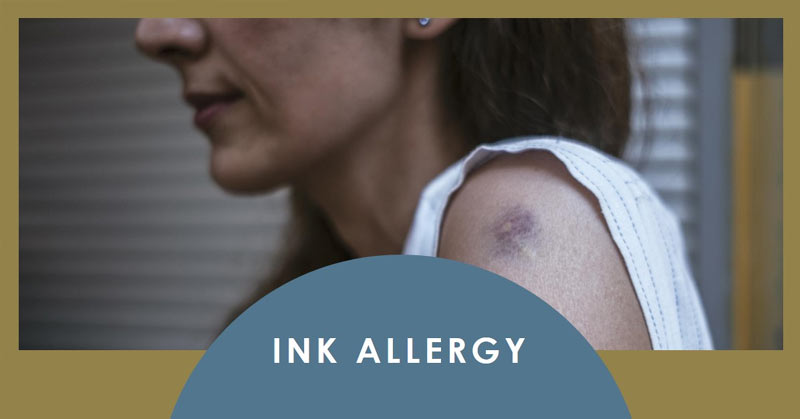Ink allergy is caused by an adverse reaction to the solvents, pigments, or metals used in ink. This can occur in various forms, such as tattoo ink allergy or newsprint ink allergy. Tattoo ink allergies are often triggered by certain pigments, especially the red pigment, while newsprint allergies stem from the solvents present in the ink used for printing.

Tattoo ink allergy manifests as rashes, itching, eczema, hives, or even blistering. Most allergic reactions are related to the red pigment, but other colors like yellow can also cause allergic reactions. The presence of metal oxides in the ink further contributes to these allergic reactions. Newsprint ink allergies, on the other hand, can result in hives, rashes, and itchy skin.
Symptoms of Ink Allergy
Ink allergy symptoms typically affect the skin. Common signs include:
- Rashes – Red, irritated patches on the skin.
- Hives – Raised, itchy welts on the skin’s surface.
- Bumps – Small, swollen areas that can be itchy or tender.
- Itchy Skin – Persistent itching, particularly around the site of the tattoo or exposure to newsprint ink.
- Blistering – Fluid-filled blisters that may develop on the skin.
In rare instances, the allergy can become more severe, leading to symptoms like difficulty breathing, dizziness, and anaphylaxis. These cases require immediate medical attention.
Preventing Ink Allergy
Taking preventive measures is key to avoiding an ink allergy. For individuals considering a tattoo, it’s crucial to inform the tattoo artist of any known allergies to metals or dyes. Before getting a tattoo, inquire about the specific pigments and metals used in the ink, particularly red or yellow pigments that tend to trigger allergic reactions. Following proper aftercare procedures can also reduce the likelihood of developing an allergy after receiving a tattoo.
In terms of preventing newsprint allergy, it is advisable to avoid handling freshly printed newspapers. Another helpful trick is to place the newspaper in an oven on low heat for 15 minutes, which helps reduce the intensity of the chemicals that might cause allergic reactions.
Treating Ink Allergy
If you suspect an allergic reaction to ink, whether from a tattoo or newsprint, it’s important to consult a dermatologist or allergist. A healthcare professional may prescribe topical steroid creams to reduce inflammation and treat the allergic reaction. Allergy tests can also be conducted to pinpoint the specific allergen causing the reaction.
Treating Tattoo Ink Allergy
In the case of tattoo ink allergy, treatment might involve a combination of topical creams and oral antihistamines to manage itching and inflammation. In severe cases, the tattoo may need to be removed if the reaction is persistent and not responding to treatment. It’s essential to follow the prescribed aftercare and avoid scratching the affected area, as this could lead to infection.
Treating Newsprint Ink Allergy
For those suffering from newsprint ink allergies, treatment involves avoiding exposure to the ink, wearing protective gloves, and washing hands thoroughly after handling newspapers. For skin reactions, topical corticosteroids or antihistamines can be used to alleviate the symptoms. In more severe cases, oral medications may be needed to control the allergic reaction.
Newsprint Ink Allergy
Although newspaper ink is usually a minor irritant, it can affect the skin and eyes, particularly for individuals with heightened sensitivities. Some people may experience an allergic reaction to rosin, a substance derived from the sap of spruce and pine trees, used in newspaper ink and other products like varnishes and cosmetics.
Skin Allergies
Allergic reactions to rosin can cause an itchy skin condition known as acute allergic contact dermatitis. The skin becomes red, itchy, and inflamed after contact with the allergen, requiring immediate treatment to alleviate discomfort and prevent further complications.
Eye Allergies
The delicate skin on the eyelids is highly susceptible to allergens, including newspaper ink. As a result, contact with newsprint can cause eye irritation, swelling, and itchiness, especially for individuals prone to allergies from other substances like cosmetics or dust mites.
Asthma
Allergy to rosin can also exacerbate asthma symptoms. Those with asthma may experience worsened respiratory symptoms when exposed to newsprint ink, particularly if they are allergic to rosin. Ensuring proper ventilation and reducing exposure to ink can help manage these symptoms.
Prevention of Ink Allergy
The best approach to ink allergies is prevention. This involves:
- Avoiding allergenic ingredients: Ensure that products, whether tattoo inks or newspapers, do not contain rosin or other known allergens.
- Using protective measures: Wear gloves or protective clothing when handling products that may contain allergenic substances.
- Proper hygiene: Wash your hands with warm water and soap after handling inked materials, such as newspapers.
Treatment Options
Treatment for ink allergy, especially contact dermatitis, may involve a variety of medical interventions:
- Immunosuppressive Drugs: These medications help regulate the immune system’s response to allergens, reducing the severity of symptoms.
- Antibiotics: If the skin has become infected due to persistent scratching or blistering, oral or topical antibiotics may be prescribed.
- Topical Steroids: Steroid creams or ointments can alleviate inflammation, itching, and swelling in the affected areas.
- Moisturizing Creams: To soothe irritated skin and aid healing, emollients and moisturizing creams can be beneficial.
Ink allergies can be bothersome but are often manageable with appropriate prevention and treatment strategies. Whether it’s tattoo ink or newsprint ink, understanding the triggers and taking proactive steps can help you avoid allergic reactions and enjoy life without discomfort.
1 Comment
Can I get this cream or something similiar to it at the drug store